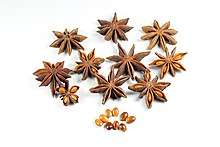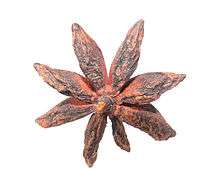Illicium verum
| Illicium verum | |
|---|---|
 | |
| Star anise fruits and seeds | |
| Scientific classification | |
| Kingdom: | Plantae |
| Clade: | Angiosperms |
| Order: | Austrobaileyales |
| Family: | Schisandraceae |
| Genus: | Illicium |
| Species: | I. verum |
| Binomial name | |
| Illicium verum | |
| Synonyms[1] | |
| |
Illicium verum is a medium-sized evergreen tree native to northeast Vietnam and southwest China. A spice commonly called star anise, staranise, star anise seed, Chinese star anise, or badian that closely resembles anise in flavor is obtained from the star-shaped pericarps of the fruit of I. verum which are harvested just before ripening. Star anise oil is a highly fragrant oil used in cooking, perfumery, soaps, toothpastes, mouthwashes, and skin creams. About 90% of the world's star anise crop is used for extraction of shikimic acid, a chemical intermediate used in the synthesis of oseltamivir (Tamiflu).
Nomenclature
Illicium comes from the Latin illicio meaning "entice". In Persian, star anise is called بادیان bādiyān, hence its French name badiane.
Use
Culinary use


Star anise contains anethole, the same ingredient that gives the unrelated anise its flavor. Recently, star anise has come into use in the West as a less expensive substitute for anise in baking, as well as in liquor production, most distinctively in the production of the liqueur Galliano.[2] It is also used in the production of sambuca, pastis, and many types of absinthe. Star anise enhances the flavour of meat.[3]
It is used as a spice in preparation of biryani and masala chai all over the Indian subcontinent. It is widely used in Chinese cuisine, and in Malay and Indonesian cuisines. It is widely grown for commercial use in China, India, and most other countries in Asia. Star anise is an ingredient of the traditional five-spice powder of Chinese cooking. It is also a major ingredient in the making of phở, a Vietnamese noodle soup.
It is also used in the French recipe of mulled wine, called vin chaud (hot wine). If allowed to steep in coffee, it deepens and enriches the flavor. The pods can be used in this manner multiple times by the pot-full or cup, as the ease of extraction of the taste components increases with the permeation of hot water.
Medicinal use
Star anise is the major source of the chemical compound shikimic acid, a primary precursor in the pharmaceutical synthesis of antiinfluenza drug oseltamivir (Tamiflu).[4] Shikimic acid is produced by most autotrophic organisms, and while it can be obtained in commercial quantities elsewhere, star anise remains the usual industrial source. In 2005, a temporary shortage of star anise was caused by its use in the production of Tamiflu. Later that year, a method for the production of shikimic acid using bacteria was discovered.[5][6][7] Roche now derives some of the raw material it needs from fermentation by E. coli bacteria. The 2009 swine flu outbreak led to another series of shortages, as stocks of Tamiflu were built up around the world, sending prices soaring.[8]
Star anise is grown in four provinces in China and harvested between March and May. It is also found in the south of New South Wales. The shikimic acid is extracted from the seeds in a 10-stage manufacturing process which takes a year.
Toxicity
Japanese star anise (Illicium anisatum), a similar tree, is highly toxic and inedible; in Japan, it has instead been burned as incense. Cases of illness, including "serious neurological effects, such as seizures", reported after using star anise tea, may be a result of deliberate economically motivated adulteration with this species. Japanese star anise contains anisatin, which causes severe inflammation of the kidneys, urinary tract, and digestive organs. The toxicity of I. anisatum, also known as shikimi, is caused by its potent neurotoxins anisatin, neoanisatin, and pseudoanisatin, which are noncompetitive antagonists of GABA receptors.[9]
Swamp star anise Illicium parviflorum is a similar tree found in the Southern United States, and should not be used for folk remedies or as a cooking ingredient, as it is toxic.[10]
Standardization of its products and services
- ISO 676:1995 - contains the information about the nomenclature of the variety and cultivars[11]
Identification
- Refer to the 4th edition of the European Pharmacopoeia (1153)
Differentiation from other species
Joshi et al. have used fluorescent microscopy and gas chromatography[12] to distinguish the species, while Lederer et al. employed thin layer chromatography with HPLC-MS/MS.[13]
Specifications
- ISO 11178:1995 - a specification for its dried fruits[14]
- GB/T 7652:2006 - a Chinese standard of the product[15]
| Star anise | |||||||||||||||||
| Chinese | 八角 | ||||||||||||||||
|---|---|---|---|---|---|---|---|---|---|---|---|---|---|---|---|---|---|
| Literal meaning | "eight edges" | ||||||||||||||||
| |||||||||||||||||
References
- ↑ "The Plant List: A Working List of All Plant Species". Retrieved 3 September 2015.
- ↑ "Galliano". Retrieved 13 March 2016.
- ↑ "Spaghetti Bolognese". In Search of Perfection. BBC Two.
- ↑ Wang, G. W.; Hu, W. T.; Huang, B. K.; Qin, L. P. (2011). "Illicium verum: A review on its botany, traditional use, chemistry and pharmacology". Journal of Ethnopharmacology. 136 (1): 10–20. doi:10.1016/j.jep.2011.04.051. PMID 21549817.
- ↑ Bradley, D. (Dec 2005). "Star role for bacteria in controlling flu pandemic?". Nature Reviews Drug Discovery. 4 (12): 945–946. doi:10.1038/nrd1917. ISSN 1474-1776. PMID 16370070.
- ↑ Krämer, M.; Bongaerts, J.; Bovenberg, R.; Kremer, S.; Müller, U.; Orf, S.; Wubbolts, M.; Raeven, L. (2003). "Metabolic engineering for microbial production of shikimic acid". Metabolic Engineering. 5 (4): 277–283. doi:10.1016/j.ymben.2003.09.001. PMID 14642355.
- ↑ Johansson, L.; Lindskog, A.; Silfversparre, G.; Cimander, C.; Nielsen, K. F.; Lidén, G. (Dec 2005). "Shikimic acid production by a modified strain of E. coli (W3110.shik1) under phosphate-limited and carbon-limited conditions". Biotechnology and Bioengineering. 92 (5): 541–552. doi:10.1002/bit.20546. ISSN 0006-3592. PMID 16240440.
- ↑ Louisa Lim (18 May 2009). "Swine Flu Bumps Up Price Of Chinese Spice". NPR.
- ↑ Perret, C.; Tabin, R.; Marcoz, J.-P.; Llor, J.; Cheseaux, J.-J. (2011). "Malaise du nourrisson pensez à une intoxication à l'anis étoilé" [Apparent life-threatening event in infants: think about star anise intoxication]. Archives de Pédiatrie. 18 (7): 750–753. doi:10.1016/j.arcped.2011.03.024. PMID 21652187.
- ↑ http://balconygardenweb.com/how-to-grow-star-anise-care-and-growing-star-anise/
- ↑ International Organization for Standardization. "ISO 676:1995 Spices and condiments -- Botanical nomenclature". Retrieved 8 June 2009.
- ↑ Joshi, Vaishali C.; Ragone, S; Bruck, IS; Bernstein, JN; Duchowny, M; Peña, BM (2005). "Rapid and easy identification of Illicium verum Hook. f. and its adulterant Illicium anisatum Linn. by fluorescent microscopy and gas chromatography". Journal of AOAC International. 88 (3): 703–706. PMID 16001842. Retrieved 10 November 2007.
- ↑ Lederer, Ines; Schulzki, G; Gross, J; Steffen, JP (2006). "Combination of TLC and HPLC-MS/MS methods. Approach to a rational quality control of Chinese star anise". Journal of Agricultural and Food Chemistry. American Chemical Society. 54 (6): 1970–1974. doi:10.1021/jf058156b. PMID 16536563.
- ↑ International Organization for Standardization. "ISO 11178:1995 Star anise (Illicium verum Hook. f.) -- Specification". Retrieved 8 June 2009.
- ↑ 供销总杜南京野生植物综合利用研究院. "GB/T 7652-2006 八角". Retrieved 8 June 2009.
External links
| Wikimedia Commons has media related to Illicium verum. |